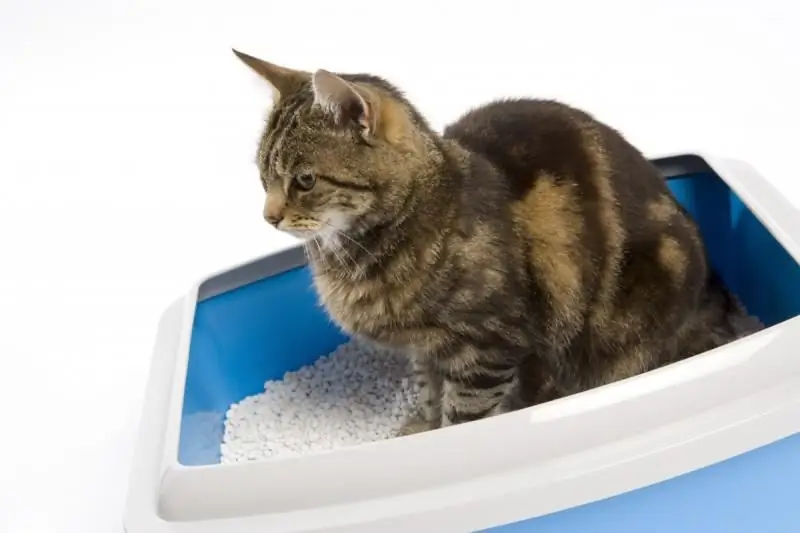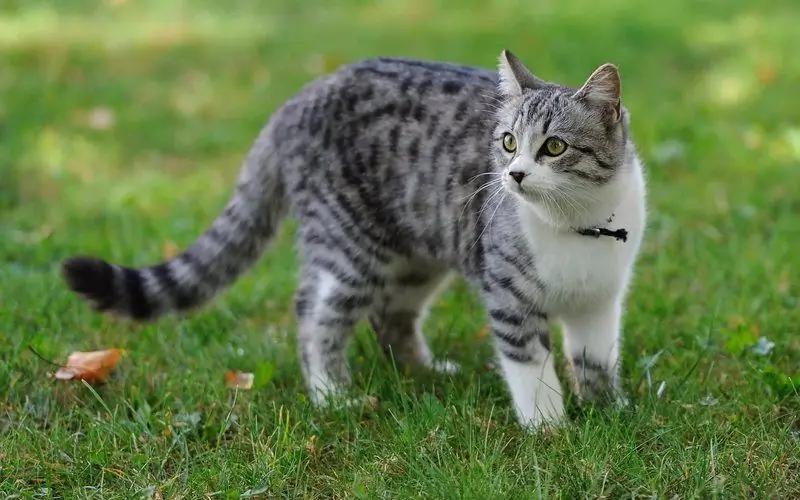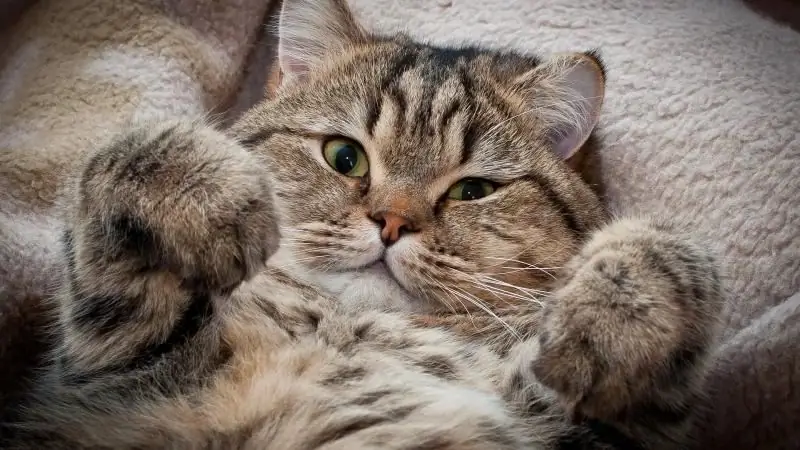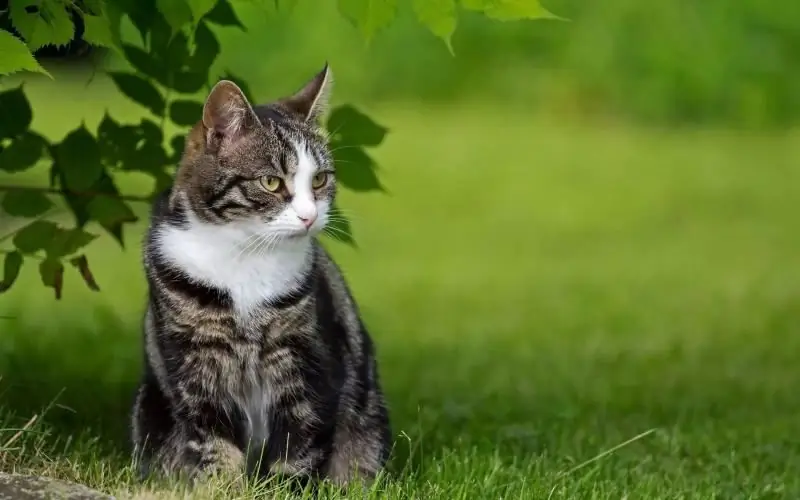
Table of contents:
- Blood in a cat's stool: how to help a pet
- Signs of bleeding in a cat's stool: hematochezia and melena
- Gastrointestinal bleeding symptoms
- Preliminary diagnostics by the appearance of feces with an admixture of blood
- Diseases in which blood may appear in the stool of a cat
- What to do if a kitten or a pregnant cat has blood in the stool
- Veterinarian reviews
- Author Bailey Albertson [email protected].
- Public 2023-12-17 12:53.
- Last modified 2025-01-23 12:41.
Blood in a cat's stool: how to help a pet

Cat owners cleaning the litter box may notice blood in the cat's stool. In diseases accompanied by bleeding into the lumen of the digestive system, the color and shape of the stool changes. A competent assessment of the situation is important, since it determines the correctness and timeliness of further actions.
Content
- 1 Signs of bleeding in cat stool: hematochezia and melena
-
2 Symptoms of gastrointestinal bleeding
-
2.1 What you can do yourself
2.1.1 Video: what to do if you find blood in your pet's feces
-
-
3 Preliminary diagnosis by the appearance of feces mixed with blood
- 3.1 Additional diagnostic methods used by the veterinarian
- 3.2 Video: causes of blood in the stool of a cat
-
4 Diseases in which blood may appear in the stool of a cat
4.1 Diagnosis of conditions complicated by the appearance of blood in the stool
- 5 What to do if a kitten or a pregnant cat has blood in the stool
- 6 Reviews of veterinarians
Signs of bleeding in a cat's stool: hematochezia and melena
The feces of cats normally have a homogeneous structure and a fairly dense consistency, a cylindrical shape and a brown color. They are characterized by a specific unsharp odor. Milk-fed kittens have a lighter color and a softer texture than adult cats.
The phenomenon in which unchanged blood or traces of it are found in the feces is called hematochezia. Hematochezia is a symptom of a condition that causes bleeding into the lumen of the cat's digestive system. Usually hematochezia indicates lesions of the departments following the stomach and duodenum.

Hematochezia is a pathology of the lower intestine of a cat, characterized by the presence of bloody traces in the feces
When the source of bleeding is located in the stomach or duodenum, the color of the stool becomes black, tarry. This phenomenon is called melena. The black color of blood is obtained from the action of the digestive enzymes of these organs on it. The consistency of the stool during chalking is usually liquid or semi-liquid, and a pungent unpleasant odor is also characteristic.

Melena - black, semi-liquid stool with a characteristic unpleasant odor, formed from blood under the influence of the contents of the stomach and intestines
Gastrointestinal bleeding symptoms
Decisive in the correct understanding of the situation are:
- assessment of blood loss;
- assessment of the general condition of the cat, since intestinal bleeding is always either a symptom or a complication of an existing disease.
Significant blood loss due to gastrointestinal bleeding is characterized by:
- the release of a large amount of melena or unchanged blood from the intestine;
- vomit with dark contents (the so-called "coffee grounds");
-
clinical picture of acute blood loss:
- depression and weakness of the cat;
- shortness of breath;
- drowsiness;
- pallor of the mucous membranes;
- lowering blood pressure;
- loss of consciousness.
If such signs appear, the cat must be urgently taken to the nearest veterinary hospital. When transported by arms, the cat's head must be below the level of the torso to prevent damage to brain cells from a lack of blood supply. A cold compress should be placed on your pet's stomach, such as a light bag of frozen vegetables from the freezer. Do not try to water or feed the cat, give it a laxative or give it an enema.
The appearance of the following signs, even with the release of a single drop of blood, also require an urgent visit to the veterinarian:
-
violation of the general well-being of the cat:
- lethargy;
- apathy;
- lack of appetite;
- increased body temperature;
- a change in the consistency of the stool, the presence of other atypical components in it - mucus, undigested food;
- vomiting;
- weight loss;
- the act of defecation in a cat is difficult or painful;
- signs of bleeding appeared against the background of an existing chronic disease of the liver, kidneys, pancreas;
- signs of bleeding appeared during treatment with corticosteroids, nonsteroidal anti-inflammatory drugs, cytostatic therapy.
The complexity of the situation also lies in the fact that in veterinary medicine there is no blood service, as in humane medicine. A very small number of really respectable clinics can call donors - healthy young animals - to take blood from them, carry out a selection according to the blood group and make up for the blood loss, but this is a waste of time and a service beyond the reach of most clinics.

Blood transfusion for a cat is a service provided by not every clinic
The cat resists shock very poorly - for example, for these animals, an adequate increase in heart rate in response to a decrease in blood pressure is unusual for these animals, as it is compensatory for humans and dogs. The first phase of shock, reactive, which is characterized by the mobilization of defense mechanisms, in a cat often passes unnoticed by others, and the animal receives attention to its state when the count goes for minutes and all its reserves are already exhausted. Therefore, a cat that has lost more than 50% of its blood volume will die.
It is important to understand that animal blood is priceless and there is practically nothing to replenish it with. Also, bleeding, assessed by the owner as insignificant, can intensify and lead to catastrophic consequences. Therefore, it is so important to show your cat to the veterinarian for any sign of gastrointestinal bleeding. It is also important to communicate with other felinologists - in difficult times, friends and their pets will quickly come to the rescue - and not refuse to help other animals if your cat can be a blood donor for health reasons.
What is acceptable to do on your own
In situations where an admixture of blood is represented as a single drop on the surface of normally colored and formed excrement, while the cat is generally feeling well, it can be assumed that the mucous membrane or anus is slightly damaged by dense feces. And only here it is permissible to observe the cat when performing a number of activities:
- deworming a cat with broad-spectrum drugs, for example, Milbemax;
-
cleansing the intestines from pylobezoars, for which they give Malt paste 1-2 hours before feeding 2-3 times a week;

Maltpasta Malta paste cleans the digestive tract of kittens and cats from hair lumps
- if the cat has constipation, add any vegetable oil to his food, you can use olive or sesame oil, start with half a teaspoon twice a day, gradually increase to a teaspoon twice a day;
- providing the pet with sufficient water;
- healing of the crack of the anus, this will be facilitated by candles with sea buckthorn oil - 2 times a day, after inserting the candle into the anus, the cat must be held in your hands for 5-10 minutes, otherwise it will push the candle out, for a single injection it is enough to cut off one third of the candle and give it a rounded shape …
If more blood is released or after these measures, the case of bleeding has recurred, you should hurry to the veterinarian.
Video: what to do if you find blood in your pet's feces
Preliminary diagnostics by the appearance of feces with an admixture of blood
The appearance of feces is of great importance, since the assessment of the degree of blood change in the intestinal contents and its distribution in the volume of excrement makes it possible to obtain preliminary data on the location of the source of bleeding.
The closer the source of bleeding is to the anus, the less altered the blood looks:
-
red-burgundy or red-brown color of excrement - with bleeding from the upper parts of the large intestine;

Feces with dark blood Dark bloody feces are characteristic of damage to the upper colon.
- bright red or cherry-raspberry color - with bleeding from the lower parts of the large intestine;
- an admixture of fresh blood is observed on the very surface of feces, which have a normal color - with bleeding from the rectum;
- discharge of pure blood without excrement - with profuse bleeding from the rectum;
- in cases of massive bleeding from a source localized in the region of the stomach and duodenum, the stool may be melena with an admixture of unchanged blood due to the fact that not all of the outflowing blood had time to react with digestive enzymes;
- with a combination of intestinal bleeding and diarrhea, the stool may have a bright red color regardless of the location of the source of bleeding, since there is an accelerated movement of its contents through the intestines, and the above signs do not have time to form;
- black color of the decorated stool can indicate stopped bleeding from the upper digestive system, and can also be observed when taking activated charcoal, iron preparations and other drugs.
Some pet food manufacturers add food colors to their products, which then whimsically color cat feces and scare owners. I advise you never to buy such products, since manufacturers of really high-quality feed invest in its ingredients and production technology, and not in a dubious marketing ploy in the form of feed coloring. If the cat was fed with such a “delicacy”, one should compare the color of the stool and the color of the food, evaluate the overall well-being of the cat, and only then draw conclusions.
Additional diagnostic methods used by the veterinarian
In addition to asking the owner of the cat and examining it, the veterinarian conducts a number of studies:
- a complete blood count - for anemia, platelet count, and signs that indicate inflammation and dehydration;
- general urine analysis - the degree of kidney involvement in the pathological process is assessed;
- biochemical blood test - clarification of the functional state of internal organs in order to diagnose the disease, as well as to determine contraindications for the use of a number of drugs;
- blood clotting test (coagulogram);
-
stool microscopy (coprogram) - assessed:
- the nature and amount of pathological inclusions (blood, mucus, undigested food fibers);
- microbial flora;
- signs of inflammatory changes;
- the presence of invasion by protozoa;
- eggs of worms.
- X-ray methods (including those with the use of contrast) - are especially important in the presence of foreign bodies;
-
Ultrasound of the abdominal organs - assess the change in the shape, structure and location of internal organs, as well as the presence of such pathological signs as free gas and fluid in the abdominal cavity (for example, with peritonitis), abscesses, tumor formations;

Cat ultrasound Ultrasound of the cat's abdominal cavity is an informative research method for detecting blood in the feces
-
endoscopic imaging using fiber optics, these examinations are carried out under anesthesia and require preliminary preparation of the animal, also through the additional channel of the endoscope, you can stop a small bleeding from a single source or take a piece of tissue for research:
- gastroscopy - examination of the gastric mucosa;
- colonoscopy - examination of the intestinal mucosa;
- laparoscopy - examination of internal organs from the side of the abdominal cavity;
- digital examination of the rectum - allows you to detect cracks in the anus, closely located tumors and polyps, abscesses of the paraanal glands, as well as personally assess the state of feces;
- histological examination of tissue samples to clarify the diagnosis - examination of the tissue structure under a microscope.
Video: causes of blood in the stool of a cat
Diseases in which blood may appear in the stool of a cat
The most common diseases in cats that cause blood in the stool are:
- invasion by helminths and protozoa, for example, lamblia or coccidia;
- constipation;
- the presence of foreign bodies in the intestines, as well as pylobezoars (hairballs);
- bacterial infection (salmonellosis);
- viral infection (panleukopenia, coronoviruses, caliciviruses);
- ulcerative and erosive lesions of the mucous membrane resulting from pancreatitis, failure of the liver, kidneys;
- abscess (abscess) of the paraanal glands;
- intestinal tumors and polyps;
- dysbiosis, inflammatory bowel diseases (ulcerative, granulomatous, plasmacytic colitis);
- erosion of the mucous membrane caused by taking medications, for example, Prednisolone, cytostatics;
- disorders in the blood coagulation system, including those caused by poisoning, for example, rat poison;
- anal fissures, damage in the anus.
Since the list of diseases in which blood may appear in the stool of a cat is extensive, all episodes of the appearance of this symptom should be discussed with the attending veterinarian, since differential diagnosis and finding the source of bleeding is not always an easy task.
Diagnosis of conditions complicated by the appearance of blood in the stool
Blood in the stool can be a symptom or complication of any disease or condition:
-
Constipation in a cat. This condition is diagnosed by a difficult, more prolonged bowel movement. The excrement is hard, it can take a shape closer to the spherical, the so-called "sheep feces". Constipation provokes damage to the mucous membrane of the large intestine, as well as the appearance of cracks in the anus. Damage to the anus causes painful bowel movements. Particularly characteristic of this disease is the appearance of a strip of fresh blood on the surface of the excrement. Required:
- changing the cat's diet;
- providing sufficient water;
- the use of a laxative;
- cleansing enemas.
-
Abscess of the paraanal gland. It is diagnosed by redness and swelling in the projection of its location, the cat tries to empty the gland - it gnaws with its teeth under its tail, "rides backwards" on the floor. As the body temperature rises, the animal becomes more lethargic. Shown emptying the gland or opening the abscess by a veterinarian.

Cat paranasal glands Treatment of an abscess of the paraanal gland in a cat is carried out by surgically opening the anal sacs and draining their cavity
- The presence of foreign bodies. Diagnosis is determined by their nature. When a foreign body with sharp edges is swallowed, the cat becomes restless, experiences abdominal pain, and red blood appears in the stool, caused by damage to the mucous membrane. If the foreign body is of considerable size, it is able to block the movement of food and supplement the clinical picture with symptoms of intestinal obstruction - nausea, vomiting, stool and gas retention, and bloating. With prolonged trauma to the mucous membrane, intoxication develops, the body temperature rises. Certain foreign bodies, such as the tubular bones of birds, can cause perforation (perforation) of the intestinal wall, followed by peritonitis, a surgical emergency. If a foreign body is able to move in the lumen of the organ,then petroleum jelly is fed to the animal and the element is expected to be released naturally. In all other cases, treatment is prompt.
-
Pilobezoars (trichobezoars, bezoars). Lumps of wool, mixing with the food mass, create a mechanical obstacle to movement through the intestines. The cat is losing weight, there is vomiting, constipation, apathy. The peak of bezoar formation occurs during the molt period of long-haired cats. In severe cases, large bezoars are removed promptly. Help consists of:
- feeding a special paste;
- transfer to feed that promotes the removal of wool;
- providing sprouted herbs to cleanse the stomach;
-
timely combing of wool.

Trichobezoar Trichobezoar is a dense conglomerate in the stomach, in some cases passing into the initial part of the small intestine, consisting of swallowed wool, gastric mucus and food particles
-
Invasion by helminths. Stool may contain clotted dark blood that is secreted from worm-caused damage to the mucous membrane. The cat loses weight, constipation alternates with diarrhea, the abdomen may swell, the appetite may sharply increase or disappear, and anemia may develop against the background of chronic blood loss. In cases of severe invasion, it is possible to block the intestinal lumen with a lump of parasites and develop intestinal obstruction. Reliable infestation by helminths is established by microscopy of the cat's feces. They are easily cured with modern anthelmintic drugs.

Prazicide Worm infestations, which can cause blood in the stool, are easily treated with anthelmintics
- Protozoa invasions. Manifested by diarrhea with blood, dehydration, exhaustion. The diagnosis is made by a veterinarian using laboratory diagnostic methods, in some cases, antimicrobial therapy is prescribed.
-
Bacterial and viral infections. They are characterized by an acute onset, fever, intoxication, the presence of symptoms other than diarrhea with blood, indicating a specific pathogen. The epidemiological situation is taken into account. Treatment is carried out exclusively by a doctor using:
- antibiotic therapy;
- hyperimmune sera;
- symptomatic remedies.
-
Blood clotting disorders. In cats, in addition to blood in the feces, there are other sources of bleeding - blood can appear in the urine, bleeding of the gums, bleeding into the cavity of the joints with swelling and soreness, under the sclera of the eye, from the nose and others. Characterized by the formation of bruising and prolonged bleeding from places of minor skin damage. Similar symptoms are observed with poisoning with rat poison containing warfarin or its analogues. Treatment is carried out only by a veterinarian:
- lavage of the stomach and intestines is performed;
- antidote is introduced - vitamin K;
- drugs are administered to stop bleeding.
-
Inflammatory bowel disease (colitis). Manifested by alternating diarrhea and constipation, the stool contains mucus and blood. Treatment is prescribed by a veterinarian after establishing the cause of colitis:
- change of feed;
- the appointment of probiotics and prebiotics;
- antibiotic therapy;
- the use of immunosuppressants.
Bleeding occurring against the background of decompensation of existing chronic diseases or ongoing drug therapy, as a rule, is anticipated by the attending veterinarian and is rarely unexpected. Usually these are severe clinical cases requiring an urgent visit to the veterinarian and revision of the treatment regimen.
Diagnosis of bleeding caused by tumors and polyps, as well as single ulcerative lesions, is carried out using endoscopic research methods, in some cases the situation requires surgical intervention to find the source of blood loss and stop it. For low-lying rectal tumors, the veterinarian can diagnose the tumor by examining the rectum and sending a sample for histological analysis.
What to do if a kitten or a pregnant cat has blood in the stool
Waiting for the appearance of blood in the stool in a pregnant cat and very small kittens is unacceptable. The animal must be examined by a veterinarian without fail, preferably at home. Blood in the stool of kittens most often indicates an infectious disease, as well as errors in the diet during weaning from the mother or food intolerance. Blood in the stool of a pregnant cat may be bloody discharge from the uterus.
Prescription of medicines is carried out only by a veterinarian, since, for example, the use of anthelmintics that are permissible during pregnancy in cats may be unacceptable in this particular individual if it has other contraindications. In severe cases, the prospect of continuing pregnancy, as well as breastfeeding, is assessed only by a veterinarian, since these conditions greatly narrow the therapeutic options. Therefore, it is important to vaccinate and proglist the cat before pregnancy.
Veterinarian reviews
Blood in the stool of cats occurs in a variety of diseases and signals the existence of a source of bleeding in the digestive system. Since the diagnosis of such conditions is difficult, and there is also a risk of increased bleeding with the subsequent death of the cat, all animals in this case should be examined by a veterinarian. In cases of minimal manifestations of blood impurities and with a good general condition of the cat, observation is possible with the condition of eliminating constipation, bezoars and helminthic invasion as the most common causes of blood in the stool. Treatment and observation of pregnant cats and small kittens with hematochezia is carried out only by a veterinarian, the prevention of such conditions is the preparation of the cat for pregnancy (vaccination, deworming, detection and treatment of chronic diseases), as well as good care during this period (quality nutrition,combing).
Recommended:
A Cat Or A Cat Pees With Blood: The Reasons For The Appearance Of Blood Urine In Kittens And Adult Animals, With What It May Be Connected, How To Treat

What does an impurity of blood in urine look like in a cat, types of hematuria, causes, list of diseases, diagnostic methods, first aid measures, prevention
Cystitis In Cats And Cats: Symptoms (blood In Urine And Others) And Treatment At Home, Medications (pills And Others), Veterinarian Advice

What causes cystitis, its symptoms, course forms, diagnosis, treatment. Caring for a sick cat, prevention of cystitis
A Cat Or A Cat Sneezes: Reasons (including Why A Kitten Has It), What To Do, Expert Recommendations

How cats sneeze. Normal sneezing. Sneezing as a symptom of disease. When to see a doctor immediately
Renal Failure In Cats And Cats: Symptoms, Treatment, How To Save A Kitten And An Adult Animal (recommendations Of Veterinarians)

Types of renal failure in cats The reasons for its development. How pathology manifests itself and is diagnosed. Inpatient and home treatment. Prevention
A Cat Or A Cat Vomits With White Foam: The Reasons For Such Vomiting In Kittens And Adult Animals, Diagnosis And Treatment, Recommendations Of Veterinarians

Vomiting of white foam in cats, what can be caused. Additional examination methods for diagnosis. First aid, treatment. Preparations for the prevention of vomiting
